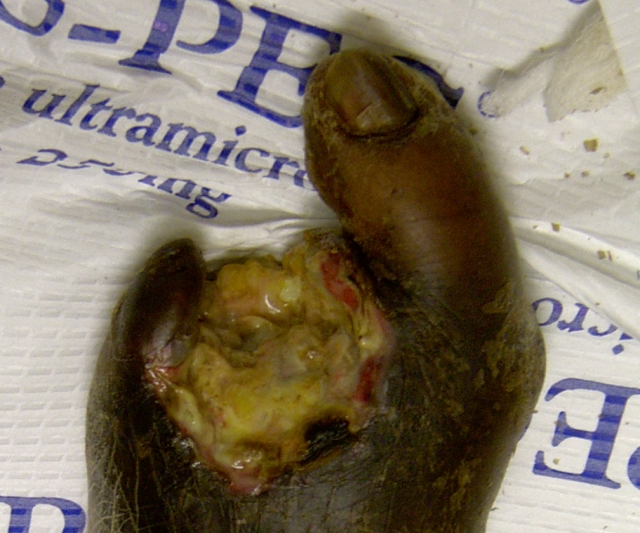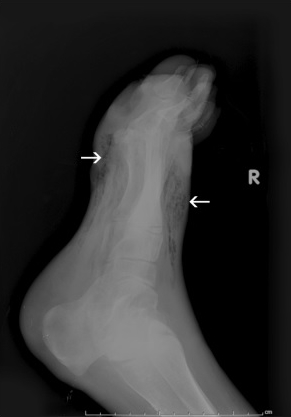Gangrene classification
|
Gangrene Microchapters |
|
Diagnosis |
|---|
|
Treatment |
|
Case Studies |
|
Gangrene classification On the Web |
|
American Roentgen Ray Society Images of Gangrene classification |
|
Risk calculators and risk factors for Gangrene classification |
Editor-In-Chief: C. Michael Gibson, M.S., M.D. [1]; Associate Editor(s)-in-Chief: Edzel Lorraine Co, D.M.D., M.D.
Overview
There are three main types of gangrene which include wet, dry, and gas gangrene. Sometimes, gangrene is also classified according to its site. [1]
Classification
There are three main types of gangrene which include wet, dry, and gas gangrene. Sometimes, gangrene is also classified according to its site. Table 1 summarizes the classification of gangrene.[1]
| Classification | Example | Description | Images |
|---|---|---|---|
| Based on Type | Dry Gangrene | Dry gangrene refers to a dehydrated necrotic tissue brought about by worsening ischemia distal to the occlusion of arteries. This is usually a worsening condition of peripheral artery disease.[2] |
 |
| Wet Gangrene | This is an infection of a compromised tissue due to poor venous or arterial flow. Most cases of wet gangrene are seen in lower extremities, where pool of gravity leading to edema is most likely to happen. However, there are some instances that wet gangrene is seen in oral and genitourinary areas. People with diabetes are at high-risk to have this infection, which is attributed to hyperglycemia and poor wound healing.[3] |
 | |
| Gas Gangrene | Gas gangrene involves the production of gas by some bacteria within the body tissues causing infections. It is a deadly form of gangrene usually caused by Clostridium perfringens bacteria. Infection spreads very fast brought about by rapid expansion of gases produced by Clostridium perfringens, thereby infiltrating the surrounding healthy tissues. Because of its ability to quickly spread to surrounding tissues, gas gangrene should be treated as a medical emergency. Gas gangrene often causes gas production, necrosisand sepsis. Rapid progression to bacteremia and septic shock is often noted. |
 | |
| Based on Site | Gangrene of the skull | Gangrene of the skull is a dark-colored area transitioning to a yellowish-off white color. This happens after a fracture, and it is considered a deadly condition once it becomes purulent, with bleb-formation on the tongue. Swelling, spasm on one side of the body, and exfoliation are the usual clinical manifestations of this condition. [1] |
 (Image courtesy of National Library of Medicine.) |
| Gangrene of the face | Noma is the term used to refer to the gangrene of the face. |  (Image courtesy of A.D.A.M., Inc. thru National Library of Medicine.)  (Image courtesy of National Library of Medicine.) | |
| Gangrene of the jaw | Tooth fracture and inflammation cause gangrene of the jaw. [1] | ||
| Gangrene of the extremities | There are several possible causes of gangrene of the extremities. These include:
Clinical manifestations include:
Signs that a gangrene is about to develop: Signs that a gangrene will not develop:
|
 (Image courtesy of National Library of Medicine.)  (Image courtesy of National Library of Medicine.) | |
| Gangrene of the ribs | Gangrene of the ribs can bring about hemoptysis, coughs, and abscesses.[1] | ||
| Gangrene of the skin | Necrotizing fasciitis affects the deeper layers of the skin. |  (Image courtesy of National Library of Medicine.) | |
| Gangrene of the genitals | Fournier's gangrene usually affects the male genitals. |  (Image courtesy of National Library of Medicine.) |
References
- ↑ 1.0 1.1 1.2 1.3 1.4 1.5 Christopoulou-Aletra H, Papavramidou N (2009). "The manifestation of "gangrene" in the Hippocratic corpus". Ann Vasc Surg. 23 (4): 548–51. doi:10.1016/j.avsg.2009.02.002. PMID 19540438.
- ↑ "StatPearls". 2022. PMID 32809387 Check
|pmid=value (help). - ↑ Al Wahbi A (2018). "Autoamputation of diabetic toe with dry gangrene: a myth or a fact?". Diabetes Metab Syndr Obes. 11: 255–264. doi:10.2147/DMSO.S164199. PMC 5987754. PMID 29910628.